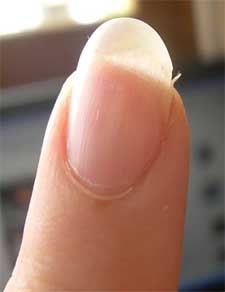 A condition where the nails suffer owing to a trauma, imbalance or disease in the body is called a nail disorder. One such state is known as eggshell nails. A person suffering from this nail disorder has curved, thin, white, and very brittle nails similar to the white of an egg. This article tries to gain further insight on this topic, technically known as hapalonychia.
A condition where the nails suffer owing to a trauma, imbalance or disease in the body is called a nail disorder. One such state is known as eggshell nails. A person suffering from this nail disorder has curved, thin, white, and very brittle nails similar to the white of an egg. This article tries to gain further insight on this topic, technically known as hapalonychia.
How Nails Become Fragile Like an Eggshell
An important part of the nail’s anatomy is its matrix. A nail rests on this tissue. This tissue is made up of blood vessels, lymph, and nerves. It is a part of the nail bed (the skin beneath the nail plate) that extends below the nail’s root. This tissue produces the cells which make the plate of the nail.
Factors like size, thickness, and length of the matrix determine the nail plate’s thickness and width. The latter’s flatness or being arched by nature is decided by the shape of a finger’s tip. Proper nutrition and care of the matrix ensure good health and growth of the nails. In a healthy matrix, cells of the older nail plate are replaced by the new ones continuously.
Nails similar to an eggshell are formed when a defect affects the matrix. As a result, softening of the nails occurs. They become prone to injuries, and the application of little pressure can either bent them or break them.
Eggshell nails can signal underlying health conditions. Hormonal imbalances, thyroid issues, or chronic stress may weaken the matrix. Recognizing these causes can lead to better management of nail health through targeted treatments.
Stresses, improper diet, usage of certain medications, presence of medical complications, or nervous disorders are some of the causes which lead to a defect in the nail’s matrix.
Treatment of Eggshell Nails
The best home remedy for this nail disorder is to grow awareness of the role played by nutrition in nail care. Intake of appropriate nutrients through food can treat this condition naturally.
Vitamin A: The nutrient vitamin A is vital for its role in cell division all over the body. When the body lacks this nutrient and calcium and vitamin D, the nails become brittle and dry.
Fresh Vegetables: Fresh vegetables, juices, cereals, milk, fish liver oil, and saltwater fish are rich sources of these micronutrients.
Vitamin B12: Lack of Vitamin B12 in the body can turn the nails dark, excessively dry, and with rounded or curved ends. The nails can develop vertical and horizontal ridges, too if this nutrient is taken below the recommended daily intake. Some of the rich sources of this vitamin are the kidney and liver of animals, dairy products, and chicken.
Iron deficiency: While iron deficiency can leave the nails brittle and thin, they can easily split owing to the low levels of the substance Linoleic acid. Less intake of iron can also make the surface of the nails concave instead of being convex. This, in turn, increases the chances of nail trauma.
Vitamin C: Vitamin C, protein, and fatty acids are the other essential nutrients required in adequate amounts for treating the symptoms of eggshell-type nails. Adopting good nail care practices like pedicure, manicure, proper cutting, and trimming of the nails from time to time go a long way in avoiding nail disorders.
Medications: Some of the prescribed medicines could also because of this problem. These medicines could hinder the flow of essential nutrients to the nails, which could cause this problem. Consult your doctor if you are taking medications.
Regular nail hydration, using oils like almond or coconut, can strengthen brittle nails. Protecting nails with gloves during chores also helps reduce exposure to harsh chemicals, promoting healthier nails.
For those facing recurring nail issues, biotin supplements can be beneficial. Studies show biotin supports keratin production, strengthening nails. Always consult a healthcare provider before adding supplements.

2 Comments
is it communicable ???
No, Annabell, it is not communicable. I’m a Nail Tech.